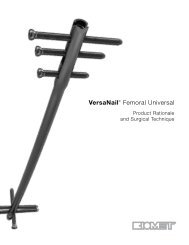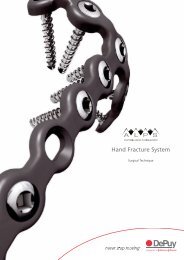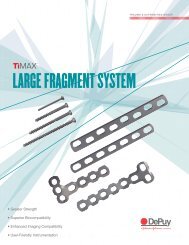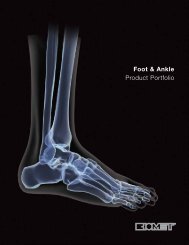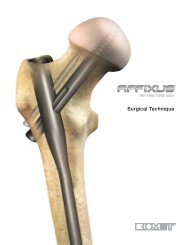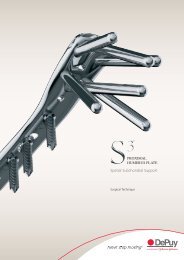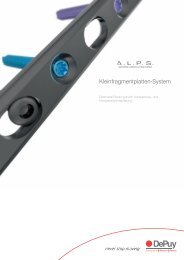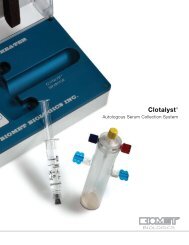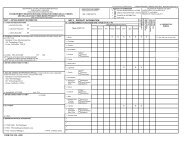VERSANAIL Tibial Nailing System Surgical Technique - Biomet
VERSANAIL Tibial Nailing System Surgical Technique - Biomet
VERSANAIL Tibial Nailing System Surgical Technique - Biomet
You also want an ePaper? Increase the reach of your titles
YUMPU automatically turns print PDFs into web optimized ePapers that Google loves.
14<br />
ESSENTIAL PRODUCT INFORMATION<br />
TECHNIQUE<br />
Place 2.5 mm bayonet-tipped K-wires in the appropriate blocking position<br />
according to the fracture. Once the nail is inserted, these are replaced by 3.5 mm<br />
solid cortical screws.<br />
ADDITIONAL ITEMS TO HAVE AVAILABLE FOR BLOCKING SCREW TECHNIQUE:<br />
Description Cat. No.<br />
2.5 mm x 9 in. Guide Wires Bayonet Point 1632-18-000<br />
2.9 mm Solid Drill Bit 8290-31-070<br />
Universal Screwdriver Handle 8241-65-000<br />
2.5 mm Screwdriver Shank 8241-57-070<br />
3.5 mm Cortical Screws 8150-36-XXX<br />
IMPORTANT<br />
This essential product information does not include all of the information necessary for selection<br />
and use of a device. Please see full labelling for all necessary information.<br />
INDICATIONS<br />
Intramedullary nails provide the orthopaedic surgeon a means of bone fixation and help generally in<br />
the management of fractures and reconstructive surgery.<br />
CONTRAINDICATIONS<br />
The use of intramedullary nails is contraindicated in the following:<br />
• active local or systemic infection;<br />
• where the nail would cross open epiphyseal plates in skeletally immature patients;<br />
• insufficient quantity or quality of bone to permit stabilisation of the fracture;<br />
• obliterated medullary canal or other conditions which tend to retard healing such as blood<br />
supply limitations, previous infections, etc.;<br />
• conditions that restrict the patient's ability or willingness to follow postoperative instructions<br />
during the healing process;<br />
• material sensitivity.<br />
The following are additional contraindications for retrograde femoral nailing:<br />
• a history of septic arthritis of the knee;<br />
• knee extension contracture with inability to attain at least 45 degrees of flexion.<br />
WARNINGS AND PRECAUTIONS<br />
These implants are intended as a guide to normal healing and are not intended to replace normal<br />
body structure or bear the weight of the body in the presence of incomplete bone healing. Delayed<br />
unions or nonunions in the presence of load bearing or weight bearing might eventually cause the<br />
implant to break due to metal fatigue.<br />
ADVERSE EVENTS<br />
The following are the most frequent adverse events after intramedullary nailing: loosening, bending,<br />
cracking or fracture of the nail; loss of fixation in bone; loss of anatomic position with nonunion or<br />
malunion with rotation or angulation; deep or superficial infection; sensitivity or other reaction to the<br />
device material.




